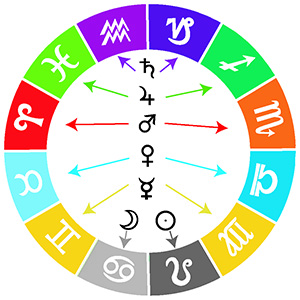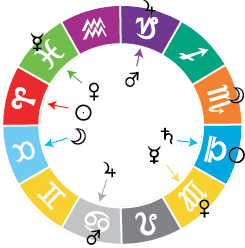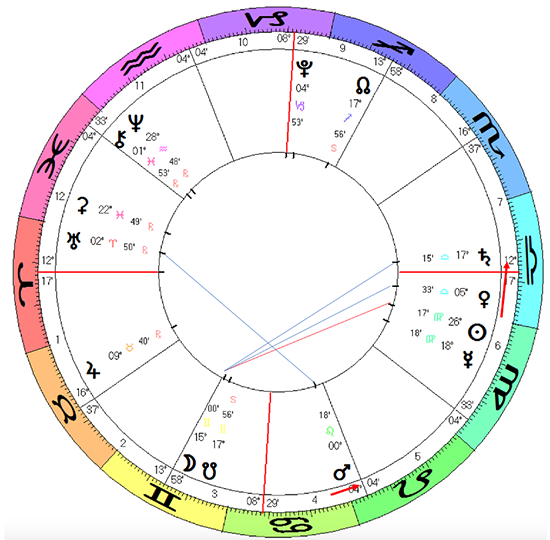Introduction:
Today horary astrology and psychological astrology are seemingly incompatible, but this need not be the case. To understand horary you need to live in the moment, aware of time unfolding along with its corresponding events. This enhances awareness and consciousness. But even more valuable for the practicing astrologer: the use of the horary chart for the first contact with a client dramatically increases the accuracy of a consultation, and transforms the ability to forecast the client’s development.
Working with inaccurate tables, naked-eye observation of the planets, and considerable mathematical ability astrologers in the past performed wonders. From Ptolemy and Vettius Valens in the 2nd century through to Nostradamus and William Lilly in the 17th century, there has been a rich history of accurate prediction. Lilly famously predicted the Great Fire of London in 1666 – and was temporarily arrested for it. Historically these astrologers worked with the horoscope for the moment – the horary chart – which was cast for the arrival of a client, the declaration of a war, the siege of a castle etc. Use of the horoscope for birth was rare, often because birth times and even birth dates where unknown.
Modern Astrology
Times have changed. Most people can access their birth time, and natal charts are the dominant method used for delineation and prediction today. Modern astrologers gravitate towards their preferred method. Alan Leo set the standard at the beginning of the 20th century for a modern approach, followed up by Charles Carter, with later astrologers diverging slightly into preferred areas. Dane Rudhyar and Alexander Ruperti were into planetary cycles and human development; Liz Greene and Stephen Arroyo, amongst many others, pioneered a psychological approach to astrology. Today there are many diverse branches of modern astrology, from harmonics to hypothetical planets to a heliocentric approach.
Horary Astrology
However, horary astrologers have been something of an outlier in sticking to old traditions. In the early 1980’s an original copy of William Lilly’s Christian Astrology, originally published in 1647, was restored and published in a beautifully bound edition (Note 1), and this contributed to a revival of Horary Astrology. This volume has to a large extent become a bible for horary astrologers. As Lilly was born before the discovery of Uranus, Neptune and Pluto, his judgements are just based on the visible planets, and no less impressive for that.
What characterizes traditional horary, apart from the absence of the outer planets, are a lot of rules, which early astrologers might often learn by heart. Making things more complex, the 12 signs had many divisions, for example into terms and faces, where planets were said to perform well or not. The horary astrologer’s task was traditionally to answer a question – Yes or No – not to explain any kind of psychological background or motivation. At this point horary astrology radically diverges from psychological astrology, which seeks to explain the character and behavior of a client, and definitely does not want to limit the client’s perceived free will by talking about a predictable future. These are two different worlds, and there is little communication between them.
Merging Psychological with Horary
There is an alternative, and in this alternative approach, the rules for character delineation and judgment are exactly the same, modern planets are taken into account, and indeed currents method for judging birth charts can also be applied to horary charts. This is because the principle is the same: the chart for here and now is a cross-section of time – you know what each planet symbolizes, where the planets have been, and you know where they are going. This makes prediction an obvious corollary of the interpretation process. All the astrologer has to do is to follow the movements of the planets to predict what is going to happen.
Modern horary astrology takes a dynamic approach, seeing the whole chart in movement: the Ascendant and Houses sweeping forward through the signs, the Moon making aspects from one planet to the next, and planetary aspects constantly applying and separating. The birth chart and the horary chart are an inflection point, offering views into the past and the future. (There would therefore be an argument for seeing a past life as described by planetary movement before birth, and for the progressed chart – a day for a year – showing the personal evolution of the individual.) The difference in horary astrology between a traditional approach and a modern is subtle – more a change from a static rules-based to a dynamic and flexible view.
In astrology, there are still a lot of assumptions being made. Why are planets said to rule specific signs? How did the 12 signs get their meaning? Why are some planets considered strong in certain signs and weak in others? There are many psychological astrologers today who reject the ideas that some planets can be weakened by their position in a sign, not least because it represents a value judgment on the client. Nevertheless, to get results in horary astrology, judging the relative strength of planets is alpha and omega. Judgments cannot be made otherwise. You cannot see if a person you meet is of good character, or if a house is worth buying, or if your own actions are ill-considered.
Planets Old and New
In both psychological and horary astrology it pays to follow the traditional rulerships – for example that Jupiter co-rules Pisces, Saturn Aquarius and Mars Scorpio. There is a symmetry to these rulerships, each dual rulership assigned to a different polarity – positive or negative. For example Aries is ruled by Mars in positive polarity, and Scorpio is ruled by a negatively polarized Mars – one directed more outwardly and the other inwardly. More importantly, the outer planets rarely represent people or things – they are more connected with collective forces, force majeure, and circumstances the individual has little control over. This is important in judgments. For example if Mercury, ruler of first house Virgo, moves to trine Neptune (modern ruler of 7th house Pisces) that is no guarantee of a fortuitous partnership, whilst if it trines Jupiter, it is.

Symmetrical system of planetary rulers
Planetary Strength
In traditional astrology, planets were considered strong in the signs they rule. This is the basis of any value judgments. According to the same logic, they are weak in the opposite sign. If, for example, Mars rules the 7th house of partnerships, and it is in Aries, then this describes a potential partner as strong, free, energized and decisive. But if Mars is in Libra, that person would be indecisive, manipulatively charming, weak and dependent on others. This is a value judgment, but you would ignore it at your peril. Planets can also be exalted or in fall, and the roots of this categorization lie far back in historical tradition. The idea seems to work in practice.
So a planet in its own sign is like someone on their own territory or in their own home – you can’t burst in and tell them what to do. A planet in their opposite sign is like an American in Russia – you had better do what Russia wants. An exalted planet is like an honored guest, the host gives this person the best place at the table. If a planet is in the opposite sign to the sign it is exalted in – in fall – then it is like someone in disgrace, like a spy pretending to belong. A person or a thing represented by a planet in fall should be avoided.

Exaltation/Fall Table
Who is Who?
When a client arrives, or a person connects, that person will always be represented by the planet that rules the Ascendant – the significator. If you are asking a question for yourself, then the Ascendant ruler is always you. It follows from this that the Descendant ruler will be the person you encounter, or your (or your client’s) partner, the MC ruler your boss, the IC ruler your home or parent etc. Things can get complicated of course. What if you are married, but are having an affair? Or if you are remarried but are having trouble with your ex? Who does the ruler of the 7th house then represent? The art of horary astrology is to decipher the clues that the horoscope itself presents – not to stick to rigid ideas.
In more complex questions, derived houses can give details, which is done by “turning” the horoscope. For example the significator for a partner’s child that is not your own, would be the ruler of the 11th house – that’s the 5th from the 7th house of the partner. Your sister’s child would be the ruler of the 7th house, the 5th house from the 3rd house etc. This is a helpful approach, but it can easily break down. The clues are in the horoscope. For example, if your sister has two children living with her, and there are two personal planets in the 3rd house, they will probably represent her children.
Past, Present and Future
When judging whether something is going to develop or happen, or not, what you are looking for is whether the significator for the person who is asking – the quesitor – is going to make an aspect to the person or thing asked about – the quesited. The aspect has to be one of the Ptolemaic aspects, that is conjunction, sextile, square, trine or opposition. An aspect like the semi-sextile, quincunx, semisquare or sesquisquare, or indeed a harmonic aspect like the quintile, will not make things happen. They may be descriptive, and indicate certain issues, but they will not bring results. The Ascendant ruler quincunx the Descendant ruler just shows two people on separate trajectories. Generally, sextiles and trines bring positive results, conjunctions bring beginnings (merging) and endings, squares bring connections but with problems, and oppositions connections characterized by distance or separation.
If an aspect between two significators has already happened, the event has already happened. If the aspect is exact, it’s happening right now. If the aspect soon takes place, or perfects, then the promised event will soon happen. The time that elapses depends on a number of factors, but the orb between the two significators is decisive. If Mercury rules the quesitor, who wants to know if he or she will get into university, and Mercury makes a favorable aspect to the 9th house ruler, and the orb is 1 degree, it is going to happen very soon and certainly within the month. If the orb is 10 degrees, time will drag out and there may be obstacles in the way.
The Moon
The Moon has a special role in horary. As it moves relatively fast in relation to the planets – from 12 to 15 degrees a day – it connects significators. The Moon functions like an intermediary, perhaps making an aspect to one significator, and then soon after to the other significator, and in this way increasing the likelihood of something happening. However, the Moon is not a trustworthy significator in itself, because is as changeable as a mood, and sometimes suggests an aspiration rather than a concrete result. Certainly the Moon will almost always show where attention is focused, and gives a strong sense of how things will develop. For example, if the Moon moves to square Saturn, the querent will experience frustration, whilst if it moves to trine Jupiter, the person will experience joy.
William Lilly posited that if the Moon made a good aspect to the Sun, then whatever was asked about could succeed. It can, but it is not a reliable indicator. As the Moon rules the sign of Cancer, then it has dual significance as Ascendant ruler and mood indicator. It is a good idea to look at the Sun as a joint significator of any house ruled by the Moon. For example, if Jupiter rules the Ascendant and Cancer is on the 5th cusp, then a trine from the Sun to Jupiter would be favorable for children, even if the Moon did not aspect Jupiter.
Horary in Practice
Whatever rules or guidelines there are, each horary chart is unique and unconstrained by rules. Each chart is a learning process, and as life unfolds and you examine events through the lens of horary, you learn more and more.

Will I be able to have a baby? September 19th, 2011. 19.24 Ahmedabad, India. AS 12.17 Aries
The following example is typical of a horary question – will I get pregnant? – which does not quite conform to any particular rules. But if you follow the dynamics of planetary movement, the answer is quite clear. The querent is Mars, ruler of Aries Ascendant. Two things draw attention: It has just left Cancer, where it was in Fall, and entered Leo, which is connected with children. This person had been unable to have children, but this movement of Mars clearly shows that conditions have changed from unfavorable to favorable. Secondly, Mars is close to the 5th house cusp – children. Two good signs.
To get a favorable answer regarding having a child, tradition says that the Ascendant ruler and the 5th house ruler should aspect each other – preferably favorably. But, traditionally, aspects can only be made and perfection attained when aspects are made within the relevant signs. What happens here is that the Sun moves out of Virgo and enters Libra, where it does in fact sextile Mars. A good sign. But there are also peripheral issues. The Moon trines Saturn, which is the ruler of the 11th house – the husband’s children. So the indications are that the husband is going to be blessed with a child.
This horary chart is typical, in that a series of favorable, though not decisive, indications give the correct answer with a degree of certainty. It was satisfying for me personally – the astrologer – who was in India at the time, in a country where astrologers proliferate, to supply the encouraging answer to this woman, who became pregnant two months later after several years of unsuccessful attempts.
End of Part 1.
Adrian Duncan March 15th, 2022
1. Christian Astrology by W. Lilly – Regulus publishing.
